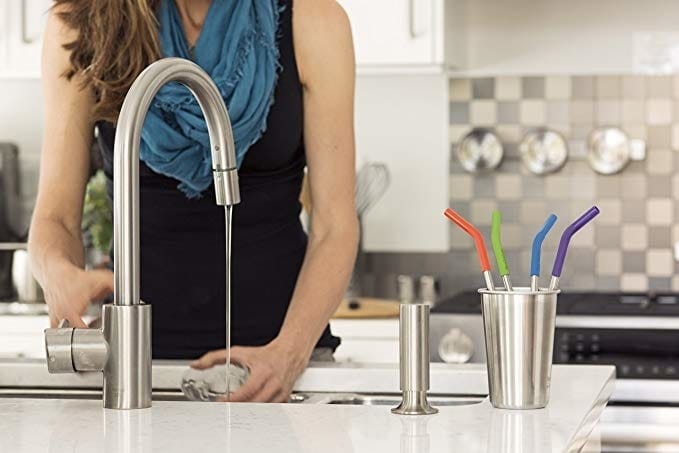9 ways to reduce your household carbon footprint right now

2. Offer chores that save energy.
Table of Contents
- As a scientist focusing on sustainability, here are nine ways to reduce your carbon footprint in under five minutes:
- 1. Host a virtual kids clothing + toy swap party.
- 2. Offer chores that save energy.
- 3. Encourage other modes of transportation.
- 4. Use reusable diapers when possible.
- 5. Switch to clean makeup.
- 6. Consider how you feed your baby.
- 7. Encourage your kids to conserve water.
- 8. Use reusable grocery bags.
- 9. Join your energy provider's energy-saving program.
As a parent, you might want to do the right things for our environment, especially knowing your children will inherit it. At the same time, with a tiny human relying on you, time is incredibly valuable.
What is a carbon footprint?
Your carbon footprint is the amount of carbon emitted as a direct or indirect result of an activity, including carbon dioxide, methane, nitrous oxide, fluorinated gases and others. Unfortunately, carbon is being released at a much faster rate than it can be absorbed by natural processes.
Currently, the average U.S. per capita carbon footprint is 18.3 tons, and the Deep Decarbonization Pathways Project reports in order to hold the global temperature rise to 2˚C or less, everyone on earth will need to average an annual carbon footprint of 1.87 tons by 2050. This seems like a lofty goal, but there are things we can do to shift emissions in a more positive direction.
As a scientist focusing on sustainability, here are nine ways to reduce your carbon footprint in under five minutes:
1. Host a virtual kids clothing + toy swap party.
It’s no secret that kids outgrow clothing and toys quickly. Consider virtually gathering fellow parents and friends, pooling together the items your kids no longer need, and going “shopping” for what you need.
Exchanging what you already have reduces greenhouse gas emissions in a few ways. It lowers the amount of power needed to produce brand new clothing and toys, and it shifts demand away from the plane and truck fuel used to fulfill online orders. Plus, it’s an opportunity to socialize and save your hard-earned money.
2. Offer chores that save energy.
Recycling and turning off the lights, air conditioner and the heat may be simple tasks, but they’ll teach your little ones how to keep a green household. Explain that the less power you consume, the lower your carbon footprint and that by properly sorting recycling and food scraps, the less greenhouse gas emissions there’ll be in landfills. You can have kids help to place recycling in the right bins each day.
3. Encourage other modes of transportation.
Biking and walking are fabulous ways to reduce carbon emissions. Encouraging your kid to get on two wheels or to take a family walk.
4. Use reusable diapers when possible.
Producing disposable diapers costs a lot of energy and emits greenhouse gases. While disposable diapers can be totally necessary, using reusable diapers even just a small percentage of the time helps lower our overall consumption and landfill waste.
5. Switch to clean makeup.
Putting on makeup can be a moment of self-care, but clean beauty is more environmentally-friendly and healthier than traditional makeup, which can be made with harmful chemicals. Plus, many women love the peace of mind that comes with using makeup free of harmful chemicals around their children.
Most traditional makeup brands use ingredients derived from fossil fuels, while clean makeup companies use more plant-based ingredients. Going clean shifts demand away from non-renewable resources towards more renewable ones which ultimately helps the environment. Clean beauty companies are also much more likely to use energy-efficient manufacturing practices, use fewer resources including fewer ingredients, reduce packaging waste, and be more responsible about sourcing ingredients in a way that’s kind to the earth.
6. Consider how you feed your baby.
Breastfeeding is great for the environment! You can make your impact even bigger by choosing eco-conscious products like reusable breast pads, or reusable breast milk storage items.
If you are bottle-feeding, opt for glass bottles if possible. And when you buy formula, see if you can find large containers instead of small—it will reduce the amount of garbage you throw out.
7. Encourage your kids to conserve water.
The more water-efficient your house is, the better as treating and pumping water uses energy. Teach your children to turn off the faucet when they’re brushing their teeth, and get them in the habit of taking showers of a reasonable length instead of baths that require three times more water than a shower.
8. Use reusable grocery bags.
Producing paper and plastic bags takes energy. Find a few reusable bags–it’s a bonus if they’re cute and fun to use–and bring them with you to the store. If you forget to use the bags, store them in places you always see. For example, you might put the bags in the driver’s seat next to your purse on your way to the store. And once you get home and unpack the groceries and put them in your entryway where you’ll see them the next time you’re heading to the car.
9. Join your energy provider’s energy-saving program.
Many energy providers offer the free option to get your power from energy-efficient sources, like wind power. Place a quick call and ask about your options. They should be able to switch you over immediately and once it’s done, you don’t have to worry about it on your to-do list anymore.


































